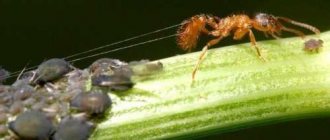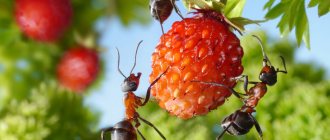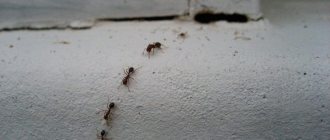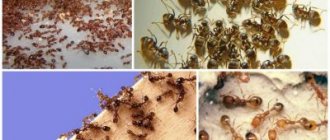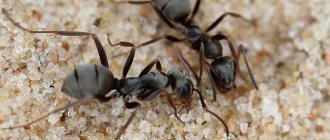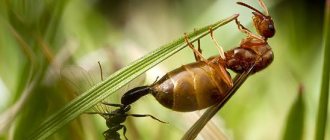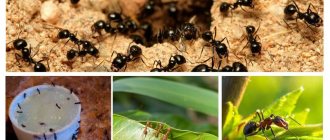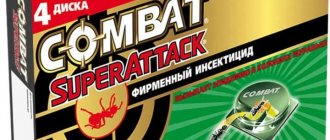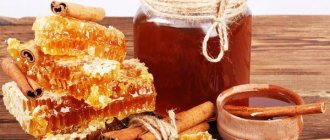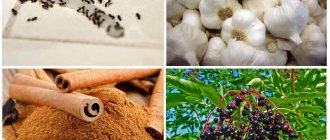The appearance of ants on fruit trees. What benefits do ants bring? What harm do they do to vegetable crops and gardens. Features of pests. Is it possible to completely destroy ants? The use of different methods and methods in the fight against ants.
There are a huge number of species of ants that differ not only in their external characteristics and habitat. For example, there are types of goosebumps that are of great benefit in natural conditions, and there are those that pose a great danger to humans and animals, since they use a sting and potent poison when attacking.
But next we will talk about ants, which are not pests, they are beneficial, but at the same time, they can cause enormous harm to fruit trees, shrubs and other garden crops.
Glass wool
Strips of glass wool at least 3 cm thick and about 12 cm wide will help get rid of ants. You need to form a funnel out of them, and then secure this structure to the trunk.
If the edge of the “skirt” is directed downward, then such a simple device will protect against insects climbing the trunk.
If the ants have already settled on the tree, then you need to point the funnel upward. You can also build an “hourglass” to stop pests from moving along the bark in both directions.
Homemade glass wool belts are periodically checked and cleaned. Traps will be most effective if you attach them to a tree in early spring before the first leaves appear.
Reasons for appearance
Before resorting to any methods of dealing with goosebumps, it will be useful to learn about them some features of their behavior and life activity, then it will be much easier to cope with them. It’s worth saying right away that these insects are quite smart, organized, hardworking, and each individual is part of a huge, well-established mechanism.
Each anthill is a colony of individuals that are divided into groups. Each group does a specific job. The main one is the uterus, which is served by working individuals, they also care for the future offspring, feed and protect them, since the uterus only lays eggs.
Depending on the species, colonies may have their own differences. The very first difference is the number of individuals, there are anthills in which there are more than a million ants. When the queen dies, the colony disintegrates, and often all the workers also die. But the red goosebumps in the colony have not one queen, but several, for this reason it is much more difficult to fight this species.
The main reason why they settle in vegetable gardens and orchards is to search for food. Often the search for a new habitat occurs in the spring. There are several reasons that increase the risk of these insects appearing in areas. The reason may be plant debris from last year, where they overwintered and are now ready to move into new territories.
Also common causes include natural fertilizers, manure heaps in which goosebumps are present. Scouts are the first to explore a new territory; if everything suits them, they bring the entire colony. Finding them on the site is not always easy, since they may not build an anthill, but live under the bark of trees, in hollows or roots.
Sintepon
A trap belt can be made from an old padding polyester taken out of a pillow or jacket. It will take at least 5 cm of material to secure it to the trunk or trunk of a fruit tree at a height of up to half a meter from the ground using twine. At the same time, beat the synthetic winterizer properly.
The rope should not be pulled too tightly to avoid constrictions on the bark.
It will be difficult for pests to overcome the obstacle; most of the ants will get entangled in it. At the same time, there is no need to use additional impregnations for padding polyester; this material is durable, does not rot, and dries quickly.
You can also form a funnel from padding polyester, with the edge directed up or down to collect ants. You should also make sure that there are no gaps between the belt and the trunk; it is advisable to cover them with clay.
Belts
When asked how to protect trees from ants and aphids, gardeners answer briefly - with hunting belts. The control method in gardening is to tie the trunks at a height of 20 cm from the soil surface. The width of each belt is individual. On average - 20 cm.
- Clothes lines are generously lubricated with Vaseline. Tie in several turns with a continuous line. Vaseline interferes with the movement of insects and does not harm trees at all.
- They fight ants and aphids in the garden with solid oil. Initially, the trunks are tied with plastic wrap. Solid oil is spread on top. The protective layer is periodically renewed.
- Tie plastic wrap around the trunk. Coat it with resin and birch tar.
- Adhesive tape or double-sided tape can protect trees. Ants, aphids, and many other insects stick to its base. You can use paper fly tape.
- You can fight ants in trees with a modern mouse trap. It is a glue for trees. The universal product is used as glue against ants. The peculiarity lies in the composition, which does not lose its properties for a long time under the influence of sun and rain. The ant repellent is applied in a continuous line in several passes. The slightest touch is enough for the insect to stick tightly. The drug is sold in any hardware or specialty store.
- Soak cotton wool in a carbolic solution, tie it around the trunk, you can use the method on bushes. After 3 days, remove the protective agent and apply a new one. Repeat the procedure three times over the summer.
You can fight ants on trees with any viscous substance that retains its properties for a long time and prevents the movement of pests.
Car tire
Using an old car tire you can make a real ditch under a tree. To do this, cut the tire in half in the center so that you get two rings of the same size. Dig a ditch around the perimeter of the fruit tree, the diameter of which will match the size of the tire.
If the size of the tree crown allows, then a tire ring can be threaded through the top part; if not, then it needs to be cut across and wrapped around the trunk, placing the structure in a ditch and securing it with soil.
The joint is sealed with tape or plasticine. Fill the container with water. Ants cannot swim, so they will not cross the water ditch and will drown.
Tree protection
It would seem that it could be easier than getting rid of small pests, because now the choice of specialized products is simply huge. But not everything is as simple as it might seem at first glance.
The fact is that every vegetable garden or garden is a piece of an ecological system in which every living creature performs a certain process. When a species is completely exterminated, the entire system is disrupted.
Therefore, even pests such as ants cannot be completely destroyed. After all, then many other pests will appear on the site, which also destroy crops and plants. The most correct and safest defense is to move the anthill.
Barrier method
Quite popular control methods used by gardeners. It has many advantages, for example, there is no need to waste time on processing, selecting medications, using hazardous substances, etc. The purpose of the method is to establish a kind of barrier to the goal of the goosebumps.
You can choose one of the options:
- Tire. You need to take the tire and cut it into two parts lengthwise. Next, dig a small ditch around the tree the width of the prepared tire and bury the tire in it. We pour water and get a water obstacle, since goosebumps cannot swim.
- Chalk. This is perhaps the most affordable, easiest, convenient and fastest method, which is also quite effective. We take regular chalk, grind it into powder and sprinkle it around the trees. Chalk works in the following way: it sticks to the paws, and the ants cannot stay on vertical surfaces; it prevents them from moving normally. You can also rub tree trunks with chalk, the effect will be the same.
- Foil. You need to make a headband out of it, something similar to a skirt. The slippery surface will not allow you to climb out onto the tree. To maximize the effect, it can be coated with sunflower oil.
Impregnation
You can prepare special solutions that are used as a repellent impregnation.
The most popular include:
- It is necessary to prepare a mixture of sufficiently thick consistency. You will need to mix soot, salt and linseed oil. It is applied to the trunk in a fairly thick layer, the width of the strip should be about 15 cm.
- It is necessary to prepare a solution of medium concentration from bleach. Remember that this substance can harm the plant if used incorrectly, always follow the instructions.
- They also use garlic impregnation and just garlic; this product will repel not only ants, but also other pests, including birds. Most often, they simply use garlic, which they rub on the bark and branches of trees. To impregnate, you need to infuse the product in water and spray the plants with a spray bottle.
Hunting belts
This option is no less popular and in demand; the advantage is the ability to use available means at hand. Regarding the width of such belts, it can be quite different, but on average you need to stick to 20 cm.
- Cotton wool. This method requires the use of a carbolic solution, which is used to wet the cotton wool. Next, you need to wrap the tree trunk with cotton wool, leave this belt for 3 days and remove it. Over the entire season, up to 5 procedures are performed.
- Scotch. You need to wrap the barrel with double-sided tape, the result will not be long in coming.
- Solid oil. It is necessary to wrap the tree with a film lubricated in grease. This substance can be replaced with birch tar or resin.
- Petrolatum. We take a clothesline and wrap it around the tree, then apply Vaseline to it. Renewing the substance from time to time.
All methods are absolutely safe for people, animals and plants themselves.
Processing of trunks
Plant care should be carried out regularly and should begin in early spring. You should not wait for huge colonies of pests to appear; the further condition and development of fruit trees will depend on your actions.
It is necessary to use solutions for spraying trees:
- Take 400 g of laundry soap, 100 ml of kerosene, 2 tbsp. carbolic acid and add to a container with 10 liters of water. The water should be a little warm, mix everything well. If there are already anthills on the site, apply the solution directly on it, and also spray the plantings in the garden.
- To process leaves, branches and bark, prepare an infusion; you will need 10 liters of water and 300 g of fresh wormwood; when there is no fresh plant, you can use dry wormwood, then take 30 g. The infusion should infuse well.
- When the fruiting period begins, you can use a solution of 5 g of soda, 30 g of linseed oil and 1 liter. water.
Regarding the effectiveness of traditional methods, the result has long been proven in practice, and they are certainly trustworthy.
Professional traps
When you don’t have the time or desire to make traps, solutions and mixtures yourself, you can turn to specialized tools for help. The main difference is the basis of all drugs that use chemicals.
They are quite dangerous for people and animals, and will also not benefit plants. They must be used strictly according to the instructions and all safety precautions must be observed.
Seedling protection
If we talk about preventive measures, you can use foil, chalk, and rinse the barrel with a stream of water. Water barriers made from tires are very effective. You can also use whitewash, but quicklime can harm young plants.
All these methods can be used during the flowering period. In case of severe infestations, you will need to seek help from chemicals to save the seedlings.
Remember that you can always use several different traditional methods at the same time, which will significantly increase efficiency and help in difficult situations.
Smells
Harmful insects cannot tolerate strong odors. Therefore, it is possible to get rid of them by scattering fragrant herbs on the site. Ants especially do not like wormwood, mint, tansy, lavender, elderberry, calendula, chamomile and garlic.
Fragrant bunches are laid out under the tree, hung on the branches, and decoctions are also prepared from them for systematic spraying.
The main thing is to replace the herbs with fresh ones in time so that the smell is sharper. Experienced gardeners also advise rubbing the trunk with chopped garlic.
Professional products
If traditional methods do not help, you can get rid of ants using special chemicals. The following preparations are used to treat fruit crops:
- A great warrior. The trunks are treated with the gel in short strokes at intervals of 2–6 cm. The drug retains its properties for 20–30 days. The product attracts ants with a sweet aroma (not perceptible to humans); the insects eat part of the poison immediately, and take the other part to a nest on the body. There, the gel is eaten by those individuals that do not leave the anthill. As a result, the pest colony dies within 2–3 days. The Great Warrior is produced in a convenient 30 ml syringe and costs about 40–45 rubles.
- Clean house. The gel has a similar effect and is available in the same syringe as the Great Warrior, but has a slightly larger volume - 35 ml. The poisonous substance remains in one place for two months. It is better not to lubricate the plant itself with the product, but to use pieces of cardboard treated with poison that are tied to the tree. The cost of the drug is 50 rubles.
- Ant-eater. The drug is sold in containers of 10 and 50 ml, in addition, disposable ampoules of 1 ml are also available. The cost of the Anteater is relatively low; for example, a 50 ml bottle costs 155–170 rubles, despite the fact that for 5 sq. m area, only 1 ml of product is needed (it is diluted in 10 liters of water). To get rid of insects, you first need to slightly dig up the anthill, then the larvae will appear on top (they are white and look like grains of rice). Afterwards, the poison is evenly poured into the ants' house. The drug continues to work for another 3 hours after use, so it affects all individuals, including those that will return to the anthill during this time. The chemical does not accumulate in the soil and does not harm pets or birds. However, the Anteater is dangerous for fish, so it should not be used near bodies of water. It is allowed to use the product for spraying potatoes, strawberries, and other shrubs that are in the growth stage, but the product cannot be used to treat the roots or seeds of plants.
Linseed oil and soot
Prepare a thick paste of table salt, oil and soot, taken in equal proportions.
The mixture must be applied to the bark in a dense layer (about 15 cm from the ground). Soot particles will stick to the ants, causing them to become poisoned.
- Author: Zimina Tatyana
Rate this article:
- 5
- 4
- 3
- 2
- 1
(0 votes, average: 0 out of 5)
Share with your friends!
Varieties
If we talk about species that are capable of settling in gardens and vegetable gardens, then here you can only find black and red goosebumps.
Redheads
It is worth saying that this species likes to settle closer to people, in other words, they are of little interest to just a garden. They prefer to be adjacent to living quarters, but at the same time they love to eat juicy, sweet fruits. To set up a colony, they choose the voids under houses, crawling through the cracks.
As already mentioned, colonies have not one queen, but several. Their nests are arranged in a rather unique way; there are several of them, each with its own queen, and they are connected to each other by special passages. If we take into account that the queen lives for about 15 years, then we hope that the colony will disintegrate and disappear.
Garden black
Despite the name, individuals of this species may differ in the color of their body. It depends on the habitat and the soil. They can be gray, black, yellow, brown. All of them perfectly adapt to new conditions, can live in absolutely any soil, and are not afraid of climate change and temperature changes.
Colonies grow quickly and, in addition to the fact that anthills are located in gardens and vegetable gardens, they can settle in residential premises. Their nests can be located in the soil, under the house, in the house, under stones, in rotten wood, in tree hollows.
Consolidate the result
Smells that repel ants After carrying out active measures, a reliable rear should be provided so that a new colony of ants cannot settle after a while.
It is necessary to seal all the cracks in the wall, the gaps between logs, in window sills, under baseboards. Do everything to prevent small insects from entering the house.
Since it is difficult to ensure complete isolation of the room, repellent substances should be used. It is better to expel uninvited guests using folk remedies.
- Place chopped garlic or whole cloves around the perimeter of the house, on window sills, behind furniture. Rub the arrows of winter garlic on the walls.
- Scatter cinnamon indoors. Suitable ground or in sticks. In the latter case, the smell lasts longer.
- Plants are laid out in the house - chamomile, peppermint, bouquets of wormwood, tansy, elderberry. In the absence of plants, you can use essential oils. They drop it into the water, rub it on the floor, walls, and leave it on a plate.
- Carry out general cleaning of the house using a vinegar solution. Ammonia has a similar effect.
If ants appear in a wooden house, it is necessary to identify the anthill, carry out disinfestation, and provide prevention
Since insects enter the house from the outside, attention should be paid to the garden area. Plant mint and calendula around the perimeter of the house, create beds with garlic
general information
Ants are widespread throughout almost the entire planet.
Currently, more than nine thousand species are known. However, in central Russia, only three of their varieties are most common:
- These ants are called Red Myrmica . Their length is 4-5 mm. The color of insects can range from red-brown to yellow. They prefer to eat various small arthropods. They are actively involved in breeding and eating aphids. They eat both living and dead insects.
- The forest red ant is characterized by medium size. Its color is black and red. Listed in the Red Book of Endangered Species.
- The black garden ant is one that mainly lives in gardens and vegetable gardens. This includes earth ants, which are relatively small in size. Their average length is 3 mm. The uterus is almost twice as large. Their length can reach 10 mm. It feeds on live and dead insects and actively breeds and eats aphids. This is their main food. Besides this, they also eat other foods.
The latter variety of ants is the subject of this article. They are of particular interest due to the fact that the life of each anthill can be characterized as social.
Black garden ant
In addition, there is a common belief that these insects are beneficial: “they work tirelessly” and the like. In fact, they, like other living beings, do what is useful to them. At the same time, they affect raspberries, cucumbers, currants, and other plants in the garden, vegetable garden or greenhouse, often causing them harm.
However, in some cases the activity of these insects has some beneficial aspects.
Harm caused
Insects are attracted to young tender buds that swell in early spring on apple, plum, cherry, pear, currant bushes and other garden plants. By damaging the buds, ants destroy the future harvest.
In the summer season, aphids appear on the leaves of garden crops - a small insect that feeds on the sap of the leaves and can cause irreparable damage to the plant. Aphid infestations are closely related to the presence of ants on trees. They breed aphids like livestock, dragging them from one leaf to another. When feeding on fresh leaves, aphids secrete a sweet liquid on their abdomen - honeydew, which is considered a delicacy by shepherd ants.
To understand that a tree is being attacked by aphids, you need to take a closer look at its leaves. Inconspicuous leaves curled into a tube on plants are a clear sign of the presence of a pest.
To protect trees from attack by insects, it is necessary to take appropriate measures in advance, and not wait until the moment when it is already useless to fight them.
How to get rid of ants on your property once and for all
Ants that have settled in a garden or vegetable garden are more enemies than friends for the owner of the property.
On the one hand, these hardworking insects command respect due to their organization, cohesion and discipline. They build anthills by making passages in the ground or making an embankment, and can also settle in the wall of a building. However, when an anthill appears in a garden, in a garden bed or in a flower bed, a large invasion of insects annoys a person. In addition, ants breed aphids; for them, these small insect pests are like cash cows; the ants feed on the sweet secretions of aphids and specifically spread these pests to plants for reproduction. To remove aphids, you will first have to get rid of the ants in the area.
It’s a fact, but aphids without ants do not spread throughout the garden so quickly and die under unfavorable conditions . Aphids settle in the garden on apple, pear, cherry, currant and other plants. Small pests prefer to live on young leaves and shoots, sucking out their juice, causing the leaves to curl and the shoots to stop growing. The aphids multiply quickly, and the ants disperse the larvae into new plants that have not been colonized by aphids. Ants, as true hosts, protect aphids from other insects and keep several individuals in the anthill in winter for reproduction the next season. When severely infested with aphids, garden trees and shrubs do not grow and do not produce crops.
When treating plants with various aphids, it is also necessary to take measures to evict the ants from the site. Having eradicated aphids from trees and shrubs, the ants will soon colonize new colonies of pests on them.
Ants independently choose a place to settle and can build an anthill in a flowerbed, garden bed, greenhouse, garden, in the wall of a building, at the roots of garden trees and shrubs, or under a garden path, from where it is difficult to expel unwanted guests. As the ants multiply, they will enlarge the anthill, making more passages deeper or increasing the earthen mounds. If you do not immediately drive the ants out of the area, their number will increase and over time it will be more difficult to get rid of the ant nest.
Garden ants require sweet carbohydrates and proteins for nutrition. Ants get sweets not only from the secretions of aphids; they can eat strawberries, raspberries, and also love sugary vegetables and root vegetables - carrots, beets, pumpkin. In flower beds, insects feast on delicate flower buds; ants can often be seen on peony or rose buds.
To get proteins for their diet, ants destroy many insect pests - various caterpillars, moths, cutworms, bark beetles and sawflies.
Ants create a huge family; in their society, each individual has its own role. One anthill can live from several thousand to a million ants. Adults are divided by profession - these are soldiers, builders, porters, scouts, nannies. Ants reproduce with the help of females and males; during the mating period they have wings and fly up to mate. After fertilization, the female sheds her wings and the males die.
A female ant or queen can live up to 20 years, an incredible age for insects, during which time she can give birth to more than 100 million worker ants and up to tens of thousands of new females and males. There may be not one female in an anthill, but several. The queen is not the main one in the anthill; it is the worker ants who select the most fertile females, settle them in the passages, feed them, and also leave the required number of larvae for each profession.
Folk ways to remove ants from a site:
You can get rid of ants in your garden using simple folk remedies without using dangerous drugs.
Many people probably tried to destroy the anthill or poison these insects, but these hard workers restore their home in a matter of days, and it is simply impossible to destroy an army of thousands of ants. You can get rid of ants in your area by scaring them off with various smells so that they move to a new place or walk around protected plants. Ants do not like the strong odors of many plants - garlic, tomato tops, mint, anise, tansy, wormwood. To scare away ants, place sprigs of fragrant greenery around the anthill and plants for protection.
Some people drive out ants using odorous herring heads, lemon, cloves, mustard powder or ground black pepper. However, these products do not guarantee that the ants will leave and not return, since the smell of herbs and other products will disappear over time.
The main way to evict ants from a site is to dig up an anthill and move it to a forest or other remote place. You can dig an anthill if it is not located in the roots of trees or shrubs, next to plants, under a path or in a wall. You need to dig tunnels deep to the lower levels where the ants place their eggs and larvae. Pour the anthill into a bucket, greasing its top with vegetable oil, or into a bag so that the insects do not crawl out. You need to dig out the anthill in the evening, when all the workers have returned home.
You can remove ants from dug holes under tiles of garden paths or in small cracks in walls and in greenhouses by covering the exits from the anthill with salt or soda on top. The insects will not be able to remove the fine powder away from their home and will go off to look for a new home.
Wood ash also effectively repels ants and is an excellent fertilizer. To protect plants from ants and other pests, place a palm-wide layer of ash around the plants or beds in a ring; ants will not pass through such a barrier.
If you regularly fill the anthill with a hose so that all the passages are filled and the ants do not have time to dry them, sooner or later they will leave the unfavorable place, but they may move nearby.
Ways to get rid of ants forever:
A simple folk method to get rid of ants on your property using yeast is effective. Take a piece or a tablespoon of dry yeast, mix it with a little water and a spoon of sugar. Pour the yeast into small cups or jars and, covering it from the sun and rain, place it around the anthill; the ants will disappear in a couple of days.
Those who do not feel sorry for numerous insects can try to remove an anthill with boiling water . It is better to fill the anthills with boiling water in the spring so that the hot water fills the lower passages and the eggs and larvae of the new generation of ants are cooked in them. By carrying out this operation monthly, you will curb the massive reproduction of ants.
You can reduce the number of ants and completely destroy them using poisonous baits . Ants love to eat sweets, prepare sweet syrup, jam or melt honey by adding a little yeast (20 g) and boric acid (5 g) per half liter. You can mix sweets with other chemicals, the ants will eat them and feed the larvae, and in a couple of days they will die.
Prevention
This includes, first of all, getting rid of aphids. To do this, you need to regularly monitor the health of your garden. Sprinkle the crown (sprinkling water), mulch (cover the surface of the earth around the plants with any materials that regulate the water and air regimes of the fertile layer), as well as water and feed the plantings. It is necessary to wash off aphids and honeydew from the leaves .
Particular attention should be paid to young shoots. It is recommended to promptly remove tops (powerful fattening shoots) and root branches. For prevention, the bark is cleaned in early spring or autumn. It is necessary to bleach the trunks regularly.
Planting repellent plants is an effective way to repel many types of ants . And plants such as parsley, dill and calendula also attract other insect predators that kill aphids:
- ladybugs,
- lacewing,
- ground beetles,
- bedbugs (some types),
- hoverflies,
- earwig,
- os.
Birds actively destroy aphids. You can attract them to your site by feeding them and building houses. They feed on aphids:
- sparrows,
- kings,
- linnets,
- wrens,
- warblers,
- tits,
- robins.
In my opinion, one of the most accessible and effective remedies against ants on trees (and not only) is medicinal chamomile, which can be purchased at any pharmacy. Many people have it growing on their property. This herb is non-toxic to humans and animals, but is very disliked by ants. The author treated areas with clusters of pests. The ants disappeared from the plantings within a few days. In addition, the author of the article successfully used unrefined sunflower oil, the aroma of which is also not liked by insects. Mixed it with water and poured it along the ant trails. After treatment, the latter left from under the bushes on the third day. Naturally, the mentioned means are far from the only effective ant repellers.
The safest and most humane way to get rid of these pests is to repel them with odors . The use of plants is a priority: they do not harm the health of people and their pets. At the same time, the pests remain safe and sound and simply leave the garden in search of other housing.
How to protect seedlings
If there are a lot of ants, then the only means of protecting the seedlings is spraying with special chemicals. As a preventative measure, install foil skirts or wash the barrel with a stream of water. The procedure is carried out several times a day.
Attention! To prevent insects from causing the death of a young plant, they use pools of tires, chalk, or the simplest method: coat the trunks with whitewash (using quicklime is dangerous). These measures are suitable as protection against insects during the flowering period, which is very important for pollination.
